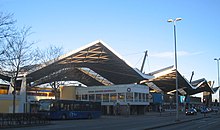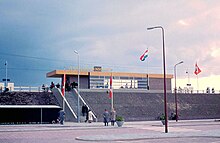Koenraad van der Gaast
Koenraad ("Koen") van der Gaast (born August 10, 1923 in Utrecht , † February 7, 1993 in Zeist ) was a Dutch architect . As the head of the construction department of the Dutch Railways , he shaped station architecture in the Netherlands after the Second World War. The Tilburg train station he designed was trend-setting for Dutch architecture in the 1980s and 1990s.
Life and work
Van der Gaast studied architecture at the Technical University of Delft from 1940 . From 1943 to 1945 he had to interrupt his studies because of the war and was only able to complete it after the end of the war by 1949. From 1950 he worked for the architecture office of PJ Koster in Zeist . After a few months he became an architect in the Department of Architecture of the Dutch Railways AG . In 1953 he became head of the office.
The need for new stations was very high after the destruction of the Second World War. With the rapidly growing number of passengers, the use of the train stations also changed. Van der Gaast shaped station architecture in the Netherlands in the decades that followed. Train stations should be flexible, offer small shopping opportunities and have a slim architecture. Since the traditional brick architecture was unsuitable for this, he mainly resorted to steel and concrete structures that were loosened up with glass and wooden elements. In the 1960s, his style changed. He was inspired by new materials and techniques, his designs became more futuristic with hyperboloids and paraboloids . With a number of train stations like those in Eindhoven, Amsterdam Sloterdijk, Schiedam, Almelo and Tilburg, it gained international attention.
From 1968 to 1983 he headed the "Design" commission of the International Union of Railways (Union Internationale des Chemins de Fer, UIC), whose headquarters in Paris he had helped design. Van der Gaast was involved in the development of internationally valid pictograms on railway stations, but also in the design concept of the Dutch railways. As chairman of an aesthetics committee in his hometown of Utrecht, he was also responsible for urban architecture. Under his leadership, the station district was radically restructured. To this day, this restructuring is one of the "most spectacular urban development projects in the Netherlands". In 1973 Van der Gaast designed the new Utrecht train station together with another architect.
Van der Gaast was married to the Dutch social geographer Sonja Bakker Schut and had four children with her.
Awards
- 1989: Medal of Merit from the City of Utrecht
- 1992: Prize of the Association of Dutch Architects (BNA)
Station building
|
|
*: tore off
literature
- Trudy van den Hurk-van Haagen, Tjeerd Boersma: K. van der Gaast (1923-1993). Transparantie en onverhulde constructies - Rotterdam: Stichting Bonas, 2004.
- Uta Römer: Koenraad van der Gaast , in: Allgemeines Künstlerlexikon (AKL). The visual artists of all times and peoples , Volume XLVI - Munich and Leipzig: KG Saur, 2005, p. 488.
Web links
- Koen van der Gaast at Architecture Guide (English / Dutch)
- Biography at stationsweb.nl (Dutch)
Individual evidence
| personal data | |
|---|---|
| SURNAME | Gaast, Koenraad van der |
| ALTERNATIVE NAMES | Gaast, Koen van der |
| BRIEF DESCRIPTION | Dutch architect |
| DATE OF BIRTH | August 10, 1923 |
| PLACE OF BIRTH | Utrecht |
| DATE OF DEATH | February 7, 1993 |
| Place of death | Zeist |


